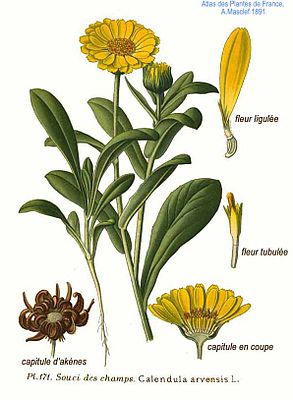Field marigold
| Field marigold | ||||||||||||
|---|---|---|---|---|---|---|---|---|---|---|---|---|

Field marigold ( Calendula arvensis ) |
||||||||||||
| Systematics | ||||||||||||
|
||||||||||||
| Scientific name | ||||||||||||
| Calendula arvensis | ||||||||||||
| (Vaill.) L. |
The field marigold ( Calendula arvensis ) is a species of the genus marigolds ( Calendula ) and within the sunflower family (Asteraceae).
description
The field marigold grows as an annual herbaceous plant and reaches heights of 5 to 30 centimeters. The low-lying or arching, branched stems are leafed up to the flower heads. The lower leaves are spatulate, short-stalked, with entire margins or bluntly toothed at a distance, the upper ones are lanceolate with a shallow heart-shaped base encompassing the stalk.
The cups have a diameter of usually 1 to 2 (rarely up to 3.5) centimeters. The wide bell-shaped envelope consists of green bracts , which are often reddish at the top and have white-skinned edges. The flowers are usually lemon yellow, less often golden yellow. The ray florets are 7 to 12 mm long and usually less than twice as long as the bracts. The strongly curved achenes , thorny on the back, are usually of three shapes within a basket. The outer, called hookfruit, end in a double-edged beak and are wingless and twice as long as the shell, the middle, called scabbard, are slightly kahn-shaped, the inner, called larval fruit, are rolled up in a ring and grooved across the back.
The field marigold flowers in Central Europe between April and October, in the Mediterranean region mostly from November to May, and rarely all year round.
The number of chromosomes is 2n = 44.
Occurrence
The field marigold has its main distribution area in the Mediterranean area including the Canary Islands and Madeira , where it is widespread and common in all floristic territories.
In Germany , the field marigold occurs as an archaeophyte in wine-growing areas and is also occasionally inconsistent. In Central Europe it is considered to be a warmth- loving species and grows in vineyards, in root crop fields, on field margins and ruderal areas on nutrient-rich, loose, calcareous clay soils. It is a characteristic of the Geranio-Allietum from the Fumario-Euphorbion association. It is considered endangered nationwide, but only occurs regularly in Baden-Württemberg as threatened with extinction and in Rhineland-Palatinate as critically endangered.
The field marigold is naturalized in South Africa , Argentina , Chile and Uruguay , rare in California and locally naturalized in New Zealand .
literature
- Erich Oberdorfer : Plant-sociological excursion flora for Germany and neighboring areas . With the collaboration of Angelika Schwabe and Theo Müller. 8th, heavily revised and expanded edition. Eugen Ulmer, Stuttgart (Hohenheim) 2001, ISBN 3-8001-3131-5 .
- Gerhard Wagenitz (Hrsg.): Illustrated flora of Central Europe. Pteridophyta, Spermatophyta . Founded by Gustav Hegi. 2nd revised and expanded edition. Volume VI. Part 4: Angiospermae, Dicotyledones 4 (Compositae 2, Matricaria - Hieracium) . Paul Parey, Berlin / Hamburg 1987, ISBN 3-489-86020-9 (revised reprint of the 1st edition (Volume VI / 2 from 1929) with addendum).
- Robert Desmond Meikle : Calendula L. In: TG Tutin, VH Heywood, NA Burges, DM Moore, DH Valentine, SM Walters, DA Webb (eds.): Flora Europaea . Volume 4: Plantaginaceae to Compositae (and Rubiaceae) . Cambridge University Press, Cambridge 1976, ISBN 0-521-08717-1 , pp. 206–207 (English, limited preview in Google Book Search).
Individual evidence
- ^ Sandro Pignatti (ed.): Flora d'Italia . Vol. 3. Edagricole, Bologna 2003, ISBN 88-506-2449-2 , pp. 139 (third unaltered reprint of the 1st edition from 1982).
- ↑ Werner Greuter : Compositae (pro parte majore): Calendula arvensis. In: Werner Greuter, Eckhard von Raab-Straube (ed.): Compositae. Euro + Med Plantbase - the information resource for Euro-Mediterranean plant diversity. Berlin 2006–2009.
- ↑ Field marigold. In: FloraWeb.de. , accessed February 25, 2012
- ^ GE Gibbs Russell, WG Welman, E. Reitief, KL Immelman, G. Germishuizen, BJ Pienaar, M. v. Wyk, A. Nicholas: List of species of southern African plants. In: Memoirs of the Botanical Survey of South Africa. Volume 2, Nos. 1–2: 1–152 (Part 1), 1–270 (Part 2), Calendula arvensis online at Tropicos .
- ↑ Flora del Conosur. Catálogo de las Plantas Vasculares. Instituto de Botánica, Darwinion. San Isidro. Prov. de Buenos Aires.
- ↑ Bruce G. Baldwin, Douglas H. Goldman, David J. Keil, Robert Patterson, Thomas J. Rosatti (Eds.): The Jepson Manual. Vascular Plants of California. 2. revised u. extended Edition. University of California Press 2012, ISBN 978-0-520-25312-4 Calendula arvensis online.
- ^ CJ Webb, WR Sykes, PJ Garnock-Jones: Flora of New Zealand. Volume IV: Naturalized Pteridophytes, Gymnosperms, Dicotyledons. 1988. ISBN 0-477-02529-3 . online .
Web links
- Calendula arvensis L., field marigold. In: FloraWeb.de.
- Field marigold . In: BiolFlor, the database of biological-ecological characteristics of the flora of Germany.
- Profile and distribution map for Bavaria . In: Botanical Information Hub of Bavaria .
- Calendula arvensis L. In: Info Flora , the national data and information center for Swiss flora . Retrieved June 8, 2016.
- Thomas Meyer: Marigold data sheet with identification key and photos at Flora-de: Flora von Deutschland (old name of the website: Flowers in Swabia )


